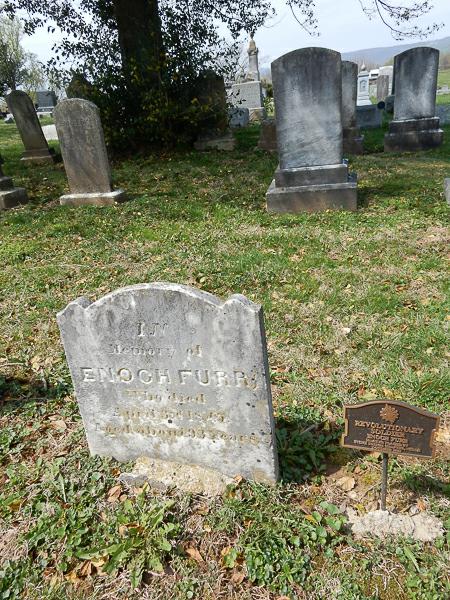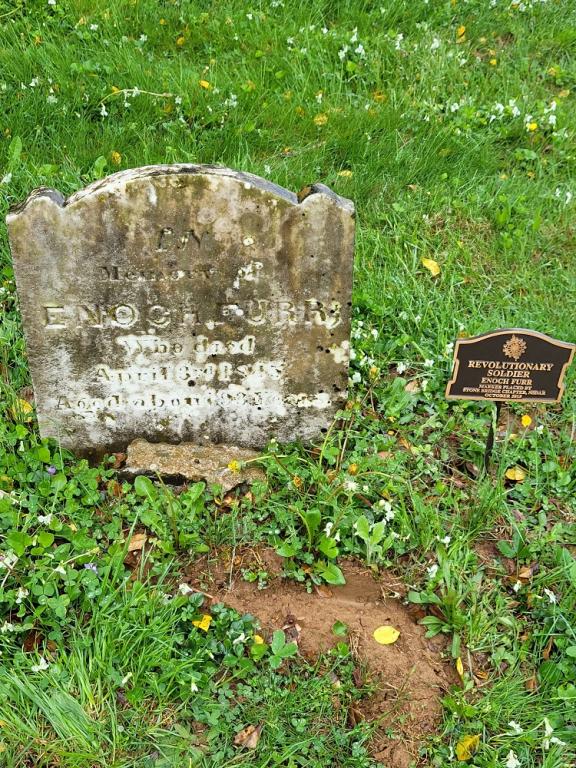Enoch FURR
SAR Patriot #:
P-163299
The following information was assembled from numerous sources and cannot be used directly as proof of Qualifying Service or Lineage.
It is considered a research aid and is intended to assist in locating sources that can be used as proof.
State of Service: VA
Qualifying Service: Lieutenant
DAR #: A042765
Birth: abt 1756 / Prince William / VA
Death: 03 Apr 1845 Bloomfield / Loudoun / VA
Qualifying Service Description:
- Lt under Capt Johnson, Colonel Midford, Loudoun County, Militia
- Lt Furr is known to have been in the Battle of Great Bridge, Norfolk, VA . Enlisted 1775
- DAR states: PRIVATE - CAPTs GEORGE JOHNSON, MCMICKEN, READ; Colonel SPOTSWOOD
Additional References:
- White, Virgil D. Genealogical Abstracts of Rev War Pension files Volume 2, pg 1294
- Enoch Furr: Book of Pensions Revolutionary Soldiers of Loudoun County, VA, pg 131
- Historical register by John Gwathmey - Virginians in the Revolution, published in 1938, pg 294, recorded as Lt June 1781
- History of Louduon County, VA by James W Head, pg 135
- SAR Patriot Index Edition III (CD: PP2210, Progeny Publ, 2002) plus data to 2004
- DAR cites: Pension Number: S*W11030
Spouse: Sarah Clawson
Children: Charity; Elizabeth; Hannah; Jeremiah; Newton; William;
Members Who Share This Ancestor
| Date Approved | Society | ACN | SAR Member Info | Lineage via Child | View Application Detail | |
|---|---|---|---|---|---|---|
| 1941-10-29 | VA | Unassigned | Herman Richard Furr (60569) | Hannah | ||
| 1943-02-12 | IL | Unassigned | Donley Leroy Furr (61934) | Newton | ||
| 1965-06-09 | DA | Unassigned | Earl Parker Anderson (83688) | Newton | ||
| 1991-01-23 | VA | 216596 | Carter Branham Snow Furr Esq. (136289) | Hannah | ||
| 2006-03-01 | WA | 24816 | Thomas Stanley Wills (166648) | Charity | ||
| 2010-09-30 | WA | 40469 | Troy Stewart Wills (178132) | Charity | ||
| 2015-03-09 | AL | 62805 | Eric Daniel Alford (193922) | Newton | ||
| 2015-03-09 | AL | 62806 | John William Alford (193923) | Newton | ||
| 2019-08-23 | FL | 88037 | Eric Gregory Cole (212646) | Charity | ||
| 2020-03-06 | AL | 90799 | Edward Dean Alford (214699) | Newton | ||
| 2020-03-06 | AL | 90800 | Darrel Edward Alford (214700) | Newton |
Location:
Bluemont / Loudoun / VA / USA
Find A Grave Cemetery #:
Marker Type:
SAR Bronze Plaque
SAR Grave Dedication Date:
15 MAY 2021
Comments:
Grave Photos and GPS provided by Craig Batten, George Washington Chapter, VASSAR
Directions to Cemetery / Gravesite:

